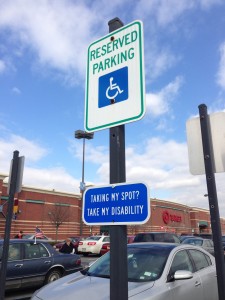Why have aspirations to improve economic prospects for disabled Americans fallen short? Legal modifications and retrenchments have reduced the effectiveness of the Americans with Disabilities Act as a set of legal tools to counter discrimination. But broader supply-and-demand factors in the U.S. labor market have also played an important role. Employed disabled people tend to be clustered into certain occupations and industries, many of which offer low wages and constricted opportunities for advancement. The clustering of people with disabilities into certain low-wage occupations can amount to a form of occupational ghettoization, reinforcing labor market inequalities that leave disabled workers at a long-term disadvantage. To better understand how future public policies could boost economic prospects for disabled workers, my colleague Michelle Maroto and I have explored the processes that create – and might break down — occupational ghettos.
Disabled Workers in the U.S. Labor Market
Using a sample from the 2011 American Community Survey of more than one million respondents aged 25 to 61 and employed in non-military jobs, my colleague and I investigated the distribution and wage earnings of workers with disabilities compared to those without disabilities in various occupations and industries. We also broke down findings for workers with specific types of disabilities, such as cognitive disabilities, motor impairments, sensory disabilities, and multiple disabilities.
Comparisons of disabled and non-disabled workers revealed a number of important patterns:
- Employed people with disabilities were less likely to be employed in higher paying occupations and those with advanced skill requirements.
- In addition to being clustered in lower-paying occupations and industries, disabled workers also earned less than workers without disabilities in particular occupations and industries. This held true even when we compared disabled and non-disabled workers who were otherwise similar in their demographic characteristics and employment histories.
- Employed people with disabilities were more likely to be over-skilled for their jobs than employees without disabilities.
- Although people with disabilities are generally underrepresented in higher paying occupations, those who do gain employment in such occupations get clear advantages in individual earnings. Breaking into good occupations is clearly important for disabled workers.
Our research also pinpoints job situations for workers with various kinds of disabilities. In the following table, the index of dissimilarity in the situations of disabled versus non-disabled workers rangers from complete integration (zero) to complete segregation (one); and the isolation index, zero to one, measures the probability that disabled worker shares an occupation or industry with other disabled workers.
Moving Forward
The barriers facing disabled workers in the United States are complex, and many are grounded in labor market processes that create and reinforce occupational segregation. To break out of low-wage job ghettos, disabled people need improved access to higher education and to appropriately tailored, up-to-date occupational training programs. Policies to further such opportunities could open the doors to higher-paying careers, for example in scientific and technological occupations, and could also help disabled applicants for jobs overcome negative stereotypes among potential employers. Decades ago, Congress reduced legal impediments for the disabled. Now it is time to help these workers gain the education and training they need to break out of dead-end occupations and find jobs where they can deploy higher skills, improve earnings, and make the U.S. economy more productive for everyone, including employers.



 Research to Improve Policy: The Scholars Strategy Network seeks to improve public policy and strengthen democracy by organizing scholars working in America's colleges and universities. SSN's founding director is Theda Skocpol, Victor S. Thomas Professor of Government and Sociology at Harvard University.
Research to Improve Policy: The Scholars Strategy Network seeks to improve public policy and strengthen democracy by organizing scholars working in America's colleges and universities. SSN's founding director is Theda Skocpol, Victor S. Thomas Professor of Government and Sociology at Harvard University.
Comments 2
kizza peter — November 5, 2015
all people should be given equal opportunities
kizza peter — November 5, 2015
equality to all